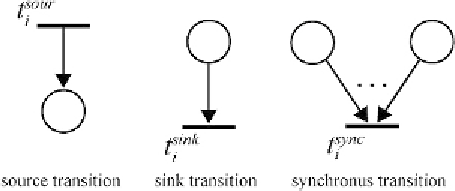Biology Reference
In-Depth Information
Fig. 1. Basic elements of Petri nets.
Fig. 2. Examples illustrating source, sink and synchronous transitions.
We here briefly give the necessary definitions of Petri net and its extension (i.e., timed Petri net) used in
the paper. For detailed definitions the reader is referred to [1].
BASIC DEFINITIONS OF PETRI NET
A Petri net is comprised of three types of elements,
places
,
transitions
and
arcs
, whose symbols are
illustrated in Fig. 1.
Definition 1
: A Petri net is denoted as a 5-tuple
PN
=
(
T
,
P
,
E
,
α
,
β
) that is a bipartite graph, where
E
=
E
+
E
−
,
T
: a set of transitions
{
∪
t
1
,
t
2
,
...
,
t
|T |
}
P
: a set of places
{
p
1
,
p
2
,
...
,
p
|T |
}
E
+
: a set of arcs from transitions to places
e
=(
t, p
)
E
−
: a set of arcs from places to transitions
e
=(
p, t
)
α
:
α
(
e
) is the weight of arc
e
=
(
p
,
t
)
β
:
β
(
e
) is the weight of arc
e
=
(
t
,
p
)
Definition 2
: Let
PN
be a Petri net.
1.
•
t
(or
t
•
) is a set of input (or output) places of
t
, and
•
p
(or
p
•
) is a set of input (or output) transitions
of
p
.
2. A transition without input arc (Fig. 2) is called
source transition
. Let
T
sour
=
{
t
sour
,
...
,
t
sour
}
1
a
1) be the set of such source transitions. A source transition is always firable.
3. A transition without output arc (Fig. 2) is called
sink transition
. The set of such sink transitions is
denoted by
T
sink
=
{
(
a
t
sink
,
...
,
t
sink
1).
4. A transition connected with two or more input arcs (Fig. 2) is called
synchronous transition
, and is
defined by
T
sync
=
{
}
(
b
1
b
t
sync
,
...
,
t
sync
}
(
c
1).
c
1


